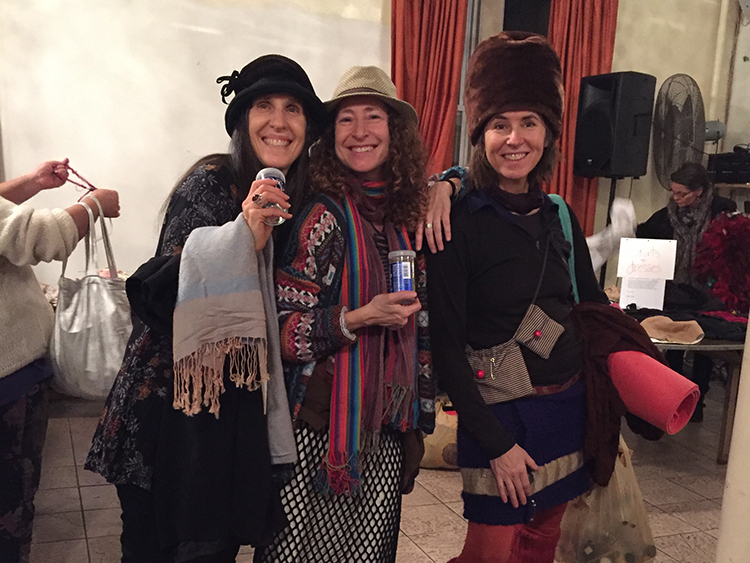When I first moved to New York City, New York, in the late ’90s, not only did I have friends with impeccable taste who purged their closets bi-annually, I also lived in a high-rise building where neighbors placed give-away items in the compactor room on each floor. My friends and I would go through each other’s “piles,” and every once in awhile, I’d wander through the compactor rooms to salvage discarded gems. Without fail, I always walked away with treasures. Years later, there are few things that bring me more joy than rescuing perfectly good items from trash, which is funny because as the youngest child of three, there were few things I despised more than hand-me-downs.
Organizing a swap or free store can bring the same good fortune to whole communities. Clothing, kitchenware, games, books, plants, and nearly anything else can find new homes. In this age of disposability, it boggles my mind knowing how many items in decent or sometimes even perfect shape end up in landfills. Swaps are win-wins for all. One person’s trash becomes another’s treasure. Someone purges abundance and someone else extends the life of what’s been discarded, diverting it from landfill. Since 2017, I’ve been organizing Swap, Share, and Shmooze events in my Hell’s Kitchen neighborhood in New York City. These events are a great way to not only swap stuff, but also share skills and form friendships.
Here are some tips for organizing your own swap or free store:
This year, we’ve seen Mutual Aid in Motion.
From scaling sharing hubs to Mutual Aid 101 trainings, we’re helping communities build the tools they need.
Every dollar fuels lasting resilience – proving that when we move together, we all move forward.
Step 1: Decide on participants. A group of friends? A whole neighborhood? An organization? They all work well. Small swaps with friends can be fun and intimate, where everyone is comfortable trying on clothing. Public events can turn up all sorts of mystery treasures.
Step 2: Secure a location. The ideas are endless: You can host a swap in in your living room, a bar, a park, a community center, a classroom, or really anywhere. Proper space can determine an event’s success. Some questions to ask: Is it large enough — is there ample space to lay things out visibly and to accommodate the number of people you expect? If it’s a public event, is it accessible to everyone? I’ve been to living room swaps where giant piles of clothing take up a whole couch, making it challenging to find things. The Swap, Share and Shmooze public event I organize takes place in a neighborhood church and has several large round tables, ideal for separating items by type.
Step 3: Determine the focus. What do you want to swap? Clothing? Kitchenware? Costumes? Jewelry? Hats? Books? Tools? All of the above? Swaps and free stores can work for anything. Decide what your focus will be, based on your space and community. Make sure your publicity is clear.
Step 4: Spread the word. Email and social media outreach can be great, especially if your swap is with friends or through an existing group. For a neighborhood event, get those paper signs to cafes, libraries, and basically anywhere there’s a bulletin board. You can get in touch with local block associations, community boards, and elected officials too.
Step 5: Choose your model. Before everyone appears with giant bags, make sure you have a plan in mind or chaos will ensue. I’ve been to apartment swaps featuring a show-and-tell of each item before it’s placed in a specified area. At our Swap, Share and Shmooze, we put signs on each table and have everyone place their own items before shopping. Volunteers help facilitate this process. We also set up a potluck snack table and one for business cards, flyers, and other materials.
Step 6: Organize a pick-up for leftovers. Even the most successful events will have unclaimed items. For small, home-based swaps, it might be easy to bring remaining items to a local shelter or thrift shop. For our larger scale events, we pre-arrange a pick-up by the United War Veterans Council or similar nonprofit organizations.
Step 7: Keep things organized. For large-scale events, collaborate with others to keep things structured and set the tone for positivity. You may even want to post ground rules. We’ve never done so but I once saw a pretty awful tug-of-war at an outdoor free store. At one of the yearly apartment swaps I go to, before officially claiming something, the item must be held up to see if anyone else is also interested. It always works out peacefully. Have your system in mind and communicate it clearly.
Step 8: Have fun, feel good, take photos, and model your finds. For clothing swaps, it is good to have mirrors available. At any event, it is important to have at least some seating. Providing drinks and snacks is a good idea, though not always necessary.

For extra credit: Host a craft and fix-it night immediately following your swap. We plan on partnering with the Fixers Collective after our next Swap, Share and Shmooze. The plan is for guests to bring broken items, toolboxes, sewing kits, and most importantly, their imaginations. Together we’ll tinker and create new lives for what might otherwise become trash.
All images courtesy of Chana Widawski

